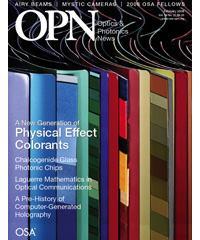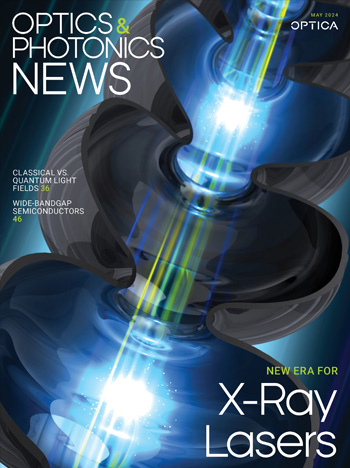
February 2008 Issue
Feature Articles
The New Generation of Physical Effect Colorants
Unlike traditional chemical dyes, physical pigments achieve their hues by directly manipulating light waves. They are being actively pursued by the printing and packaging industries, for decorative purposes, and in transportation and security.
by Faiz Rahman and Nigel P. JohnsonLaguerre Mathematics in Optical Communications
The mathematical studies done by Edmond Nicolas Laguerre in the 19th century laid the foundation for contemporary optical communications.
by Mario Martinelli and Paolo MartelliA Pre-History of Computer-Generated Holography
This month’s edition of the journal Applied Optics is a special issue devoted to the contributions of the late Emmett Leith. As a tribute to his dear friend, the author discusses the significance of Emmett’s work and his own role in inventing computer-generated holography.
by Adolf W. LohmannChalcogenide Glass Photonic Chips
Signal processing for the next generation of the Internet
by Steve J. Madden, Duk-Yong Choi, Michael R.E. Lamont, Vahid G. Ta’eed, Neil J. Baker, Mark D. Pelusi, Barry Luther-Davies and Benjamin J. EggletonDepartments and Columns
Mystic Cameras
Mysterious photos taken by lightning. Perfectly preserved images captured on the retina of a dead man’s eye. Are these bizarre phenomena grounded in fact or examples of science fiction?
Stefan Sydor Optics: A Legacy in Optics Craftsmanship
Stefan Sydor Optics was founded in 1964 as a small manufacturer of all types of optics. Since then, it has grown in size but narrowed in scope to become a leading producer of precision, flat-surfaced, parallel and wedged optics.
America COMPETES in Science: A Conversation with Rep. Bart Gordon
Our conversation with Rep. Bart Gordon (D-Tenn.)
"Airy" Beams Are Nearly Diffraction-Free
An interesting type of accelerating wave packet—a theoretical prediction made nearly three decades ago—has now shown up in laboratory experiments.
OSA Politics Get Local
Local sections have always been an important part of the Optical Society. In fact, OSA itself began as a local section.
Retinal Device Helps Study Blood Flow in Mice
A group of researchers from the Wellman Center for Photomedicine built a flow cytometer that can trace fluorescently tagged cells through the blood vessels of a mouse retina.
Did You Know?
Carnivorous plant inspires microlens array.
ADVERTISEMENT
ADVERTISEMENT
Also in this Issue
Book Reviews
In Memory
Remembering Paul Forman, co-founder of Zygo Corporation; Stanley Flatté, known for his work on wave propagation; and Donald R. Herriott, a pioneer in laser technology and past president of OSA.

![Infinity Mirrored Room– Brilliance of the Souls 2014 by artist Yayoi Kusama. [© YAYOI KUSAMA]](https://opnmedia.blob.core.windows.net/$web/opn/media/images/articles/2024/0724/departments/202407-cover-web.jpg?ext=.jpg)
![An experimental scheme demonstrated by researchers at Princeton and Yale universities, USA, can convert physical noise into errors that can be corrected more easily. [F. Wojciechowski, Princeton University]](https://opnmedia.blob.core.windows.net/$web/opn/media/images/articles/2024/0624/departments/202406-cover-web.jpg?ext=.jpg)
